Houseplant for beginners
Before diving into the specifics, it is worth acknowledging why houseplants are so beneficial:
- Air Purification: Certain houseplants are known to improve indoor air quality by removing toxins and increasing oxygen levels.
- Mental Health: Studies show that plants can reduce stress, anxiety, and depression, providing a sense of calm and connection to nature.
- Aesthetic Value: Plants bring color, texture, and life to indoor spaces, enhancing both the aesthetics and ambiance of your home.
- Productivity and Focus: Research suggests that having plants in your environment can improve focus, creativity, and cognitive function.
Plant selection
The first step to successful houseplant care is selecting the right plants for your space. The perfect houseplant can enhance your home’s aesthetic, improve air quality, and bring a touch of nature indoors. When selecting a plant, several factors, such as light conditions, temperature, and humidity in your home, as well as your skill level, must be considered to ensure your success. If you have children or pets, you may want to consider a plant’s toxicity before bringing it into your home.
- Light conditions: Different plants have different light requirements, so it is important to choose plants that thrive in your lighting conditions.
-
- Bright Light: Ideal for plants like succulents, cacti, and certain ferns. Place these plants near south or west-facing windows.
- Low Light: Suitable for plants like snake plants, pothos, and ZZ plants. These can thrive in north-facing windows or shaded areas.
- Medium Light: Perfect for plants like spider plants, peace lilies, and philodendrons. East-facing windows or areas with filtered light work well.
- Temperature and humidity: Some houseplants require higher humidity levels, while others do better in dry air.
-
- Temperature: Most house plants prefer temperatures between 65-75°F. Avoid placing plants near drafts, heating vents, or air conditioners.
- Humidity: Tropical plants like ferns and orchids thrive in higher humidity. To increase humidity, consider using a humidifier or placing a tray of water near the plants.
- Skill level: Some plants are more forgiving of neglect, while others require more attention and expertise.
- Toxicity: Be aware of your houseplants’ identity and learn if they pose potential threats to humans and pets. If you cannot identify a houseplant, contact us for assistance. If you need immediate assistance regarding poisonous or toxic plants, please consult the National Poison Center at (800) 222-1222 or dial 911.
Shopping for Plants at the Store
When choosing the plant itself, examine the condition of the foliage. Select plants with vibrant, healthy leaves. Avoid plants with yellowing leaves, brown edges, or spots, as these may indicate disease or poor health. If possible, inspect the roots. Healthy roots are white or light tan and firm. Avoid plants with dark, mushy, or overly crowded roots. Examine the plant for signs of disease or pests.
Transporting your plant
Transporting plants requires careful consideration of weather conditions. In summer, avoid leaving plants in a closed vehicle, as temperatures can rise quickly and damage them. In winter, wrap plants with newspaper or paper bags and keep them in the front of the vehicle with the heater on to prevent cold damage.
Acclimating your plant
Acclimatization is the process of gradually adjusting plants to different light levels to reduce shock. For newly purchased plants grown in high-light conditions, start by placing them in a high-light area and gradually move them to their permanent location over 4 to 8 weeks.
Caring for your plant
Understanding the needs of each individual plant is essential. Read the plant tag for guidelines on how often to water and fertilize your plants. Overwatering and underwatering are common pitfalls for houseplant owners. Dust the leaves regularly to keep them clean and allow for better photosynthesis. Turn your plants to ensure even growth. Houseplants are susceptible to various pests, such as spider mites, aphids, and scale insects. Inspect your plant for pests and treat promptly. If your plant Fortunately, there are reliable, research-based solutions for pest management. Check with Hanover Master Gardeners for help. They may offer organic or integrated pest management techniques, which minimize harm to your plants and the environment.
House Plant Recommendations from Hanover Master Gardeners
These are some of the house plants our master gardeners grow and love. Read about their characteristics and care to find the right plant for your home.
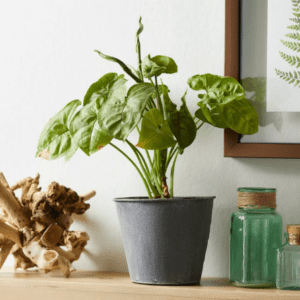
Arrowhead Plant
House Plant – 6-12 inches
Arrowhead vine is named for its heart-shape foliage. Every few weeks, this tropical plant unfurls medium green leaves splashed with white, cream, silver, pink, or purple. Grow several different types of arrowhead vine and celebrate the unique coloration of this group of easy-to-grow plants. Propagate by stem cuttings.

Coleus
Annual / Shade / Various heights
Coleus comes in many different colors. For bushier, fuller plants, keep the growing tips pinched. To extend the lush color into fall, remove any stray flower spikes that emerge — they take energy away from maintaining the gorgeous foliage, and the flowers are insignificant. If growing in the garden, sow about 12 inches apart. If growing indoors for houseplants, sow at any time, placing the young plants in a well-lit window..

Corn Plant
Up to 6 feet
Slow-growing, broadleaf evergreen. Keep it in bright to moderate filtered light indoors. It thrives in lower light level situations. Direct sun can burn the foliage, but if light levels are too low, the leaves will narrow. Keep the soil moist during the growing season but cut back on the water in the winter.
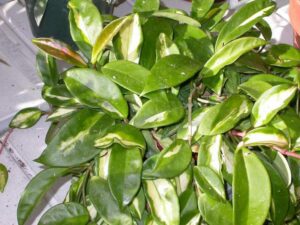
Hoya
It is best grown in a standard, loamy, well-drained potting mix. It may be trained to a small trellis or framework. Site in bright light with at least 1/2 day of direct sun. Tolerant of curtain-filtered sun and bright indirect light. Good light is necessary for flower production. Pots should not be rotated or moved to another location after flower buds appear. Water plants moderately but consistently throughout the growing season, allowing the soils to become nearly dry between water applications. In winter, plants require less bright light, less watering and tolerate night temperatures to 50F degrees. Do not remove the flowering stalk after bloom because new flowers will form on the old spur.
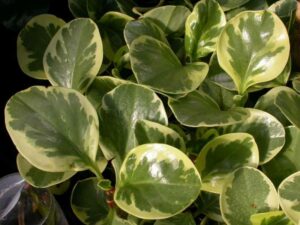
Peperomia obtusifolia
Baby Rubber Plant
This plant is easily grown as an indoor plant in a peatty potting mix in bright indirect light. Avoid direct afternoon sun. Water moderately but consistently, allowing the soils to almost dry on top before rewatering. Reduce watering from fall to late winter. Likes high humidity in summer, so consider setting plant in a humidified room or on wet pebbles. Propagate by stem or leaf cuttings. Cut back foliage as needed to maintain plant shape.
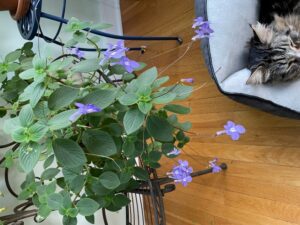
Streptocarpus
This amazing plant graces your house with a long-lasting explosion of color, practically blooming all year if grown in good conditions.
An indoor temperature of 67-75°F is ideal. Temperatures too much above 80°F tend to cause leafburn as well as reduce the blooming power and longevity of the plant. Primroses can be grown in low light conditions, although an east or west-facing window is best. They prefer high humidity and a consistently moist, but not waterlogged soil. Protect from freezing temperatures.
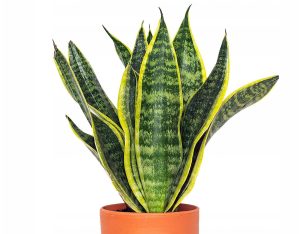
Snake Plant (Dracaena trifasciata):
Snake plants have tall, sword-like leaves that grow in rosettes. They come in various colors and patterns, including dark green, light green, white, and silver. Popular varieties include ‘Black Gold,’ ‘Moonshine,’ ‘Metallica,’ ‘Silver Queen,’ ‘Futura Robusta’ and ‘Bantel’s Sensation.’ It prefers bright, indirect light but tolerates low light areas well. It needs well-drained soil, such as cactus mix or potting soil with perlite. Water is needed only when the soil is dry as overwatering can lead to root rot.
It in average home temperatures, ideally between 70-90°F and it is best to avoid cold drafts. Fertilize monthly during the growing season with an all-purpose fertilizer at half strength. Repot every few years with fresh potting media. These plants don’t mind being snug in their containers but can break clay pots if too rootbound. It is known for its air-purifying qualities. This plant is mildly toxic to pets and humans.
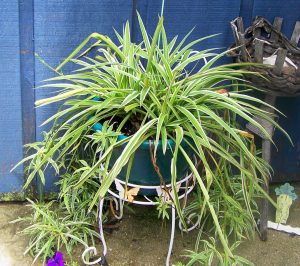
Spider Plant (Chlorophytum comosum):
Spider plants have long, arching leaves that are typically green with white stripes, though some varieties are solid green. They produce small, white, star-shaped flowers and plantlets (often called “spiderettes”) on long stems. Common varieties include the variegated type with green and white leaves, and the solid green type. There are also curly-leaved varieties. This hardy, low-maintenance plant prefers bright indirect light but tolerates low light conditions too.
Use general-purpose potting soil and know that they like to be slightly root-bound. Water once a week, allowing the soil to dry out between waterings. Browning of leaf tips is common. This is caused by low humidity, dry soil and/or chemical build up from tap water. To correct this problem, set out your water for 24 hours before using it, so the chemicals can evaporate. Ideal temperatures are between 65-75°F during the day and 50-55°F at night. Fertilize every three to four months with a balanced houseplant fertilizer. It is known to help remove indoor toxins.
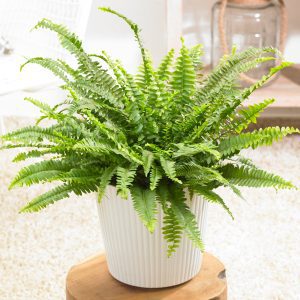
Boston Fern (Nephrolepis exaltata):
Boston ferns have long, feathery fronds that can grow up to 2-3 feet long. The fronds are typically bright green and have a graceful, arching habit. Boston ferns thrive in bright, indirect light. Direct sunlight can scorch the fronds, while too little light can cause the plant to become leggy. Use a well-draining potting mix designed for ferns or a combination of peat moss, perlite, and pine bark works well. Keep the soil consistently moist but not waterlogged.
Boston ferns thrive in high humidity, so misting the fronds regularly or using a humidity tray can be beneficial. It prefers temperatures are between 60-75°F and you should avoid placing the fern in drafty areas or near heating vents. Fertilize monthly during the growing season with a balanced, water-soluble fertilizer diluted to half strength.

Peperomia (Peperomia spp.):
Peperomias come in a variety of shapes and sizes, with leaves that can be smooth, textured, or even rippled. Common varieties include Peperomia obtusifolia (baby rubber plant) with its thick, glossy leaves, and Peperomia caperata (emerald ripple) with its deeply ridged leaves. There are over 1,000 species of Peperomia, each with unique characteristics. Some popular varieties include Peperomia argyreia (watermelon peperomia) with its striking leaf pattern, and Peperomia prostrata (string of turtles) with its small, round leaves. These plants prefers bright, indirect light but can tolerate lower light conditions and avoid direct sunlight, which can scorch the leaves.
Use a well-draining potting mix. A mix designed for succulents or a combination of peat moss and perlite works well. Water when the top inch of soil feels dry as overwatering can lead to root rot, so it’s important to let the soil dry out between waterings. Ideal temperatures are between 65-75°F and they do not tolerate cold drafts or temperatures below 50°F. Fertilize monthly during the growing season with a balanced, water-soluble fertilizer diluted to half strength.
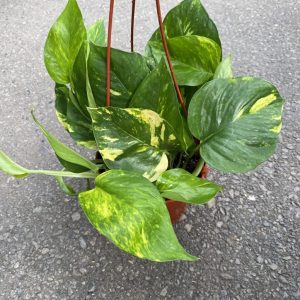
Pothos (Epipremnum aureum):
Pothos is versatile, and thrives in various light conditions from low to moderate light and requires little maintenance. Pothos plants have heart-shaped leaves that can be green, variegated with white, yellow, or light green. They are typically glossy and can grow quite large in ideal conditions. Prune to control the length of the vines and encourage bushier growth. Common varieties include ‘Golden Pothos’ with yellow variegation, ‘Marble Queen’ with white variegation, and ‘Neon Pothos’ with bright green leaves. Use a well-draining potting mix.
A mix designed for houseplants, or a combination of peat moss and perlite works well. Water when the top inch of soil feels dry. Overwatering can lead to root rot, so it’s important to let the soil dry out between waterings. Ideal temperatures are between 60-80°F and know that Pothos do not tolerate cold drafts or temperatures below 50°F. Fertilize monthly during the growing season with a balanced, water-soluble fertilizer diluted to half strength. Remove any dead or yellowing leaves to maintain the plant’s appearance. You can also propagate it from cuttings, ensuring your plant continues to grow and flourish. Pothos is toxic to people and pets so consider that factor before bringing it into your home.
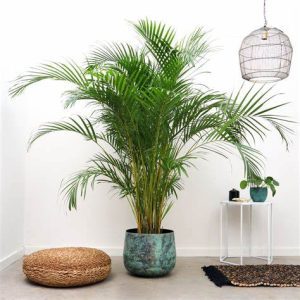
Areca Palm (Dypsis lutescens):
Also known as the butterfly palm, it is a popular houseplant known for its feathery, arching fronds and adds a tropical feel. It prefers bright, indirect light. Direct sunlight can scorch the leaves, while too little light can cause the plant to become leggy. Use a well-draining potting mix such as mix designed for palms or a combination of peat moss, perlite, and sand. Keep the soil consistently moist but not waterlogged. Water when the top inch of soil feels dry. Areca palms also appreciate high humidity, so misting the fronds regularly or using a humidity tray can be beneficial.
They prefer temperatures are between 65-75°F and you should avoid placing the palm in drafty areas or near heating vents. Fertilize monthly during the growing season with a balanced, water-soluble fertilizer diluted to half strength.
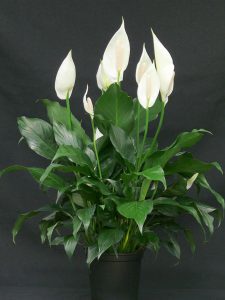
Peace Lily (Spathiphllum):
Peace lilies are popular houseplants known for their lush foliage and elegant white blooms. These plants thrive in bright, indirect light but they can tolerate low light conditions, however this may reduce reblooming. Keep the soil consistently moist but not waterlogged. Water when the top inch of soil feels dry. Peace lilies are sensitive to chlorine and other chemicals in tap water, so using distilled or filtered water is recommended. These plants prefer high humidity. You can increase humidity by misting the leaves regularly or placing the pot on a tray filled with pebbles and water.
Peace lilies do well in temperatures between 65-80°F (18-27°C). Avoid placing them in drafty areas or near heating/cooling vents. Use a well-draining potting mix that is designed for houseplants or a blend of peat moss, perlite, and pine bark works well. Feed your peace lily with a balanced, water-soluble fertilizer every 6-8 weeks during the growing season (spring and summer). Avoid over-fertilizing, as this can cause leaf burn. Note this plant is toxic to people and pets.

